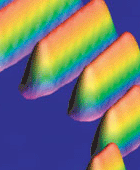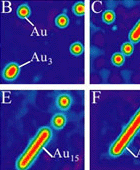Irvine, Calif., August
28, 2002
While it may not make much of an anniversary present,
a gold chain built atom by atom by UC Irvine physicist Wilson Ho offers an
answer to one of the basic questions of nanotechnology—how small can you
go?
In the first study of its kind, Ho and his colleagues have
discovered the molecular phase when a cluster of atoms develops into a
solid structure, a finding that can have a significant impact in the
future development of metal structures built at the molecular scale. The
study—which appears on the Science Express website, a service
of Science magazine—also
suggests a limit on the tiniest size that electrically conductive
molecules can be constructed, and it presents a new method for researchers
to build and examine these structures.
"This research answers
fundamental questions on how solids form from an assembly of single
atoms," said Ho, the Donald Bren Professor of Physics & Astronomy and Chemistry. "It allows us for the first time to see matter form in its
smallest unit, and it can have important implications for the construction
of metallic nanostructures that can be used in catalysis, electronic
circuits and data storage."
Ho, working with fellow UCI researchers Niklas Nilius
and T. Mitch Wallis, employed a scanning tunneling microscope to build a
chain of gold atoms in order to measure how electron states change as more
atoms are added to the chain. Starting with a single atom and adding one
at a time, the researchers succeeded in measuring the electrical
conductivity in these states as the atoms shared electrons, and these
measurements varied dramatically as atoms were added to the chain. The
scanning tunneling microscope enabled the researchers not only to
manipulate individual atoms but also to capture images of the chain and
measure its properties. As a result, the researchers were able to obtain a
clear connection between the geometry of the fabricated nanostructure and
its electronic properties.
As the researchers added the fifth and
sixth atoms, the chain began to exhibit the collective properties of a
bulk structure, which is when atoms in a molecule lose their individual
characteristics and assume those of the overall structure. It is at this
point when a metallic molecule becomes conductive and can be used as an
electrical conduit.
Ultimately, the gold chain reached 20 atoms
long, although in principle there is no limit to how long a chain can be
built. In measurements taken as the chain grew from six atoms to 20, the
states for the electrons showed only small variations and had practically
converged to show properties typical of solids with a larger number of
atoms. Ho said that the consistency of these latter measurements further
support the concept that a functional gold structure can be built with as
few as six atoms.
"What these experiments provide is a new way to
study the electronic properties of materials at a nanoscale," Ho said. "We
have been able to build a gold bulk structure with six atoms, but in a
larger scale, we are starting to answer the question of how many atoms are
needed to build a material that has potential utility.
"While it is
not practical to mass produce these chains as one-dimensional conductors,
catalysts or data storage devices, these studies provide a scientific
basis for future nanotechnology," he added. "The results from this
research contribute to our understanding of the behavior of matter as a
function of its size."
In further research, Ho and his colleagues
are studying the electronic properties both of gold atoms constructed in a
two-dimensional array and of a chain of silver atoms. Ho used gold in this
study because of its unique electronic properties that can be readily
observed and controlled through the use of a scanning tunneling
microscope. By extending the present study to include other types of
atoms, it would be possible to understand a wide range of materials such
as alloys, magnets and catalysts at the nanoscale.
Nilius is a UCI
postdoctoral researcher, and Wallis is a graduate student on
leave-of-absence from Cornell University. The National Science Foundation
funded the research.
 A scanning tunneling
microscope image of gold chains
A scanning tunneling
microscope image of gold chains

